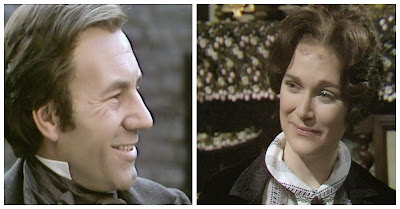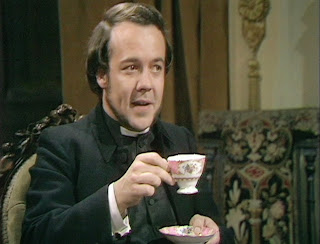When I first discovered this on Amazon last summer, my near
initial reaction was “What!!!??? Another North and South??? How can there be?
What in the world do they think they're doing?” (Never mind, of course,
that it was done thirty years before you-know-what. Entirely beside the point.)
All most unsettling–very.
But on the other hand, if there was another (decent)
version of N&S, how could we not watch it? The whole idea had a kind
of dreadful fascination...and then there's all that about having an open mind.
The cost when it was released was quite prohibitive, so in
the end–still with highly mixed feelings–I placed a purchase request for it at
the library. They agreed to get it and we were #1 on a hold list that promptly
shot to almost 10. So far so good. We settled down and began waiting...and
waiting...and waiting...and waiting some more. Weeks passed. Then–guess what
happened? The week, the very week before our big trip, it arrived. Of
course, there was no possible way to fit an almost four hour movie into our
last long/short/busy/final week at home, so we had to send
it back unwatched. An agonizing experience.
But–we thought–at least it will give us something to look
forward to after coming home. By this time–due to studying the movie case
firsthand, watching the trailer, etc.–our mixed feelings were rapidly dissipating
and we were eager to see it. Fortunately in the end, it more than fulfilled our
expectations. :-) So now for my review...
First off there were a number of familiar faces:
 |
Robin Bailey as Mr. Hale (appeared several times in the
b/w Robin Hood tv series with Richard Green) |
 |
Kathleen Byron as Mrs. Hale
(Miss Lavender in the 1975 BBC Anne of Avonlea mini-series) |
 |
Tim Pigott-Smith as Frederick
(Mr. Hale in the 2004 BBC North and South) |
 |
Shirley Cain as wife-of-the-new-vicar-of-Helstone
(Mrs. Phillips in the 1985 BBC P&P) |
Secondly–sets and so forth: The sets are well done, while
the costumes and hairstyles are really quite good and not too dated. We were a
little worried in the first scene, but that concern quickly ironed itself out.
(While I'm on the subject–Margaret has a particularly gorgeous, gold-colored,
wide-sleeved jacket during the riot scene. ;-)) All in all everything feels
very true to period. Higgins and Bessy are well played, pretty much straight out
of the book–as are Mr. and Mrs. Hale, Mrs. Thornton, and Fanny.
And now for what you're all really wondering about...
Mr. Thornton and Margaret Hale
Patrick Stewart is of course famous for his role in
Star Trek (which I have not seen), and I think he does an excellent job as
Thornton. I fully entered into Margaret's initial misunderstanding and dislike
of him. He was loud, quick, and imperious, but he could smile unexpectedly,
too–even laugh. And yes–he has an accent!
Rosalind Shanks did a wonderful job as Margaret.
Very gentle
and soft-spoken she does an outstanding job carrying the weight of the changes
Margaret goes through–reflecting both the sorrow and quiet joy. She has very
speaking eyes, the sweetest smile, and is a true lady throughout.
Together, Thornton and Margaret were very good. The errors
and need for growth on both sides comes across clearly and the romantic element
is very present. Sparks fly and there are definitely strong undercurrents from
the get-go. *Warning (bit of a spoiler here): the riot happens and–then bang!
there it is–and between them there's no going back. :-) And then they show
afterward–I
mean, how she gets up to the sitting room while in a faint. ;-) Okay, end of
spoiler.* I didn't do too badly, did I? Anyhow, lest that make you nervous,
there are no even remotely indecent scenes–or even scenes where you feel it
possibly
could go odd.
~Some miscellaneous points: Boucher has far more brains here
and orchestrates the riot–which works fine. ~ The first part of the story goes
pretty much point by point and the second part moves faster, condensing a bit
of the development–personal development on both sides and also as regarding the
mill failure. ~ There were some gentle, yet quite humorous moments–two that
spring to mind being the duty-bent constables and Lennox's anecdote about
Tennyson (which was hilarious if you've read any Tennyson). ~ And finally, the
whole film has much of the direct religious language and influence of the book.
The biggest divergence was that they left out the whole
Leonards/Margaret/lying episode. More on this another time (as looking at how
it's played out in the book). At the moment I'll just say I view it as a
crucial point in her personal character development as well as encapsulating the
different themes of the story, raising the stakes, and highlighting all the
misunderstandings and misinterpretations. That being said, they do stick to and
capture the broader themes involved and they do have Thornton trying to protect
Margaret's reputation, along with Mrs. Thornton's involvement, etc.–which is
all good and well done.
Some things are more out in the open than they are in the
book (or in the '04) and near the beginning particularly I think Margaret comes
across as more decided. For instance, after returning home to Helstone she
speaks of the “veneer” of fashionable London society and of how she wants a
“useful” life–which I believe she actually comes to desire
over the course
of the story itself and fully realizes when she returns to London near the
end. But that's not a make-it-or-break-it issue as far as being able to enjoy
the film. Part of the reason I like Margaret's character is that she
is sometimes
uncertain and still
acts, even when she can't make sense of all that is
going on in her life. Thinking about it again though, I think she actually does
become
less decided as the story progresses, so perhaps they were trying
to bring out how she goes from that attitude of “having everything figured out
and knowing exactly where she's going” to that state of utter dependence upon
God's will, mercy, and goodness that all of us should be striving for.
Going into it, I was initially nervous that it would change
my perception of the story in the sense of, “Is this true? Is this really the
story? Have I been misreading it all this time?” (I've had that experience
before with something else.) But it didn't. It was just a different take on it.
And as far as the films go I think you can like both versions (I do at least)
without viewing one or the other as “better”. Both are faithful to the book,
diverging about the same amount–just in different areas.
My final verdict? Is that I thoroughly enjoyed it–still find
it thought-provoking–would like to see it again–and am thrilled to be able to
recommend it without reservation!



















